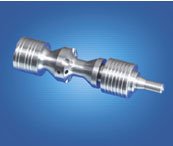Precision milled parts in small batches
PROTEC GMBH Zerspanungstechnik
77716-D Haslach im Kinzigtal
12 Schleifmattstr.
+49 7832 7090
+49 7832 70950
Precision milled parts in small batches
Anfrage an Anbieter senden
-
Material Selection:
- Choose the appropriate material for the specific application and customer requirements. Consider factors such as material properties, machinability, and cost.
-
Tool Selection:
- Select cutting tools suited for the material being milled. Carbide end mills are commonly used for milling operations. Consider tool coatings and geometries that enhance tool life and performance.
-
Cutting Speeds and Feeds:
- Optimize cutting speeds and feeds based on the material being machined. Adjust parameters to achieve the desired balance between material removal rates and tool life. Higher cutting speeds are often possible for softer materials.
-
Workholding:
- Choose appropriate workholding methods to secure the workpiece during milling. Precision vises, fixtures, or custom workholding solutions may be necessary to ensure stability and accuracy.
-
CNC Programming:
- Develop precise and efficient CNC programs for the milling operation. Consider toolpath optimization, tool changes, and tool offsets. Verify and simulate the program to catch any potential issues before machining.
-
Toolpath Optimization:
- Optimize toolpaths to minimize tool changes, reduce cycle times, and maximize efficiency. Efficient toolpaths contribute to improved surface finish and reduced machining time.
-
Coolant and Lubrication:
- Use appropriate coolant or lubrication to dissipate heat, improve chip evacuation, and extend tool life. Adjust the coolant flow and type based on the material being machined.
-
Quality Control:
- Implement rigorous quality control measures to ensure that each part meets specifications. Regularly inspect critical dimensions and tolerances throughout the production process. Use precision measurement tools such as calipers, micrometers, and coordinate measuring machines (CMMs).
-
Documentation:
- Maintain thorough documentation throughout the machining process. Record machining parameters, tool changes, and any adjustments made during the production run. This documentation is valuable for quality control and process optimization.
-
Prototype and Testing:
- Consider producing a prototype or small test batch to validate the machining process before full-scale production. This can help identify and address any issues early in the manufacturing process.
-
Efficient Tool Changes:
- Minimize downtime by optimizing tool change processes. Use tool changers and preset tools to reduce the time required for tool changes, improving overall production efficiency.
-
Batch Management:
- Implement effective batch management systems to track and manage small production runs. This includes proper labeling, segregation, and organization of parts to avoid errors and mix-ups.
-
Post-Machining Processes:
- Consider any required post-machining processes such as deburring, surface finishing, or coating. These processes contribute to the final appearance and functionality of the milled parts.
-
Safety Precautions:
- Adhere to safety guidelines when operating milling machines. Ensure that operators are properly trained and equipped with the necessary personal protective equipment (PPE).
Turning
Gridding
Milling



